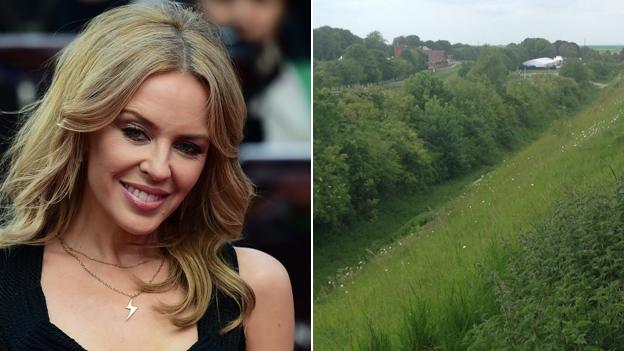Devil's Dyke: Ancient monument 'degraded' by walkers and dog poo
- Published

People on top of the Devil's Dyke during a concert at Newmarket Racecourses in 2015
An Anglo-Saxon monument that has protected status had been "degraded" by walkers and dog waste, a council said.
The Devil's Dyke earthbank in Cambridgeshire has both Site of Special Scientific Interest and has Scheduled Ancient Monument statuses.
East Cambridgeshire District Council cited it in a document aiming to get developers to create wildlife sites.
Craig Bennett, national chief executive of the Wildlife Trusts, said there was a "tension" over access and protection.


The rare chalkhill blue butterfly is found at the Devil's Dyke
The Devil's Dyke
a man-made defensive barrier dating from the 6th and 7th Centuries
seven and a half miles long stretching from Reach to Woodditton and crossing the Newmarket Racecourses site
up to 100ft high in some places
home to many wildlife species including the rare lizard orchid flower and chalkhill blue butterfly
one of 22 protected sites in East Cambridgeshire District Council area
a public right of way exists along the top of the dyke

In a planning document, external approved last week, the council set out conditions new housing developments must meet to "protect the natural environment".
It said that at the Devil's Dyke "habitat degradation is occurring, particularly through trampling of vegetation and soil enrichment from dog excrement".
It added there were also issues with littering, fires and dogs off leads posing "a risk" to grazing livestock.
The Dyke is privately-owned, but it is managed by a partnership of landowners, Natural England, English Heritage, the Bedfordshire, Cambridgeshire & Northamptonshire Wildlife Trust, and Cambridgeshire County Council.

The Devil's Dyke is protected for its flora and fauna as well as its historic importance
Mr Bennett, who lives in Cambridgeshire, said it was "important we build understanding about what are right ways to behave on these very precious nature sites".
Many sites run by the Wildlife Trust have signage and some have staff "engaging" with the public, but it had "been difficult" recently due to staff being furloughed, he said.
He added that "ultimately we need more space for nature", which would reduce numbers visiting protected sites.
East Cambridgeshire District Council said new developments of more than 150 homes should create or fund a "new rich wildlife habitat" either on the development or at another site.
It said these off-site areas should be "adjacent to strategically important biodiversity areas" such as the Devil's Dyke.
Councillor David Brown said the authority was making sure new developments "both protect the natural environment and create new areas for wildlife to thrive".

Find BBC News: East of England on Facebook, external, Instagram, external and Twitter, external. If you have a story suggestion email eastofenglandnews@bbc.co.uk, external
- Published15 August 2020

- Published31 May 2020

- Published27 May 2015
